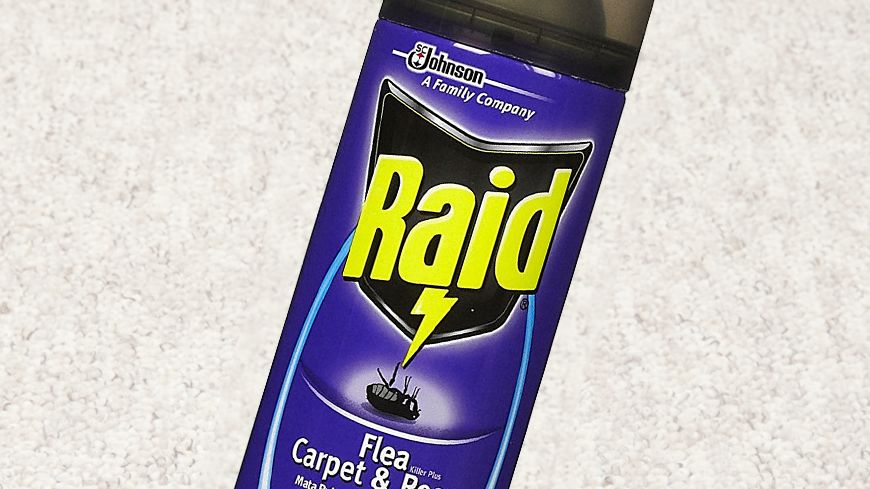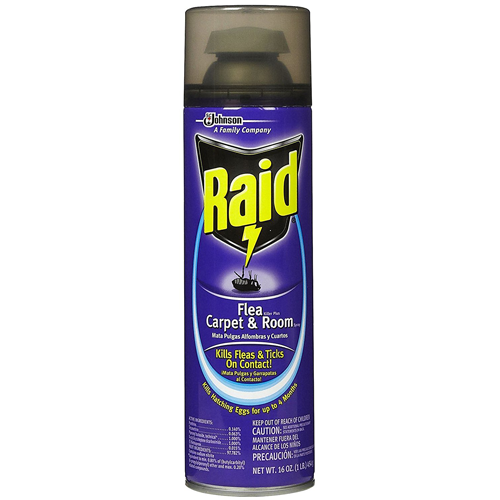Summary
Raid Flea Killer Plus Carpet & Room Spray is used to control and prevent indoor flea infestations. Raid contains pyrethrins and pyrethroids to quickly kill adult fleas. And methoprene, an insect growth regulator (IGR), stops new eggs and larvae from becoming adults.
Raid Flea Killer Plus
Raid’s premise spray will control fleas for 4 months indoors.
Raid Flea Killer Plus contains less IGR than many other professional premise sprays. Raid’s concentration of methoprene (0.015%) results in it lasting for 4 months. While Precor 2000 Plus contains 0.085% methoprene and lasts 7 months indoors.
| Product name | Raid Flea Killer Plus Carpet & Room Spray |
| Active ingredients | 0.015% (s)-methoprene 0.140% pyrethrins 0.063% tetramethrin 1.000% MGK 264 1.000% piperonyl butoxide 97.782% other ingredients |
| Target pest | Fleas & ticks |
| Kills | Adults, eggs & larvae |
| Duration | 4 months |
| Size | 16 ounces |
| Capacity | n/a |
| Application | Aerosol spray |
| Use on | Home premises |
| Manufacturer | SC Johnson |
| UPCs | 046500016516 046500016455 |
| Product label | view |
| MSDS | view |
| Shop | Amazon.com |
| Price | $13 |
| Customer reviews | Read reviews |
| Competitors | Browse premise sprays |
- Prices are based on Amazon.com at time of publishing.
Details
How Raid Flea Killer Plus Carpet & Room Spray Works
Methoprene
The most important ingredient in flea premise sprays is the insect growth regulator (IGR). This is because 95-99% of infestations consist of eggs, larvae, and pupae. These stages live in the environment, usually at the base of carpets. Traditional insecticides can’t penetrate carpets well and they have a short residual effect. IGRs are more effective, because they last much longer indoors (4 to 7 months). Also, IGRs are considered the safer choice, because they target hormones that are rarely found outside of insects.
The IGR in Raid’s premise spray is (s)-methoprene, also called Precor. Methoprene mimics an insect hormone called juvenile hormone (JH). When JH or an IGR is present, immature insects will never pupate into adults. The IGR causes insects to die as pre-adults, because it remains present when endogenous JH fades. So, flea eggs and larvae never become adults. As an added bonus, IGR-exposed adult females can’t lay viable eggs.
Pyrethrins & Pyrethroids
Pyrethrum is a natural insecticide found in Chrysanthemum flowers. Pyrethrins and pyrethroids are derivatives of pyrethrum, and are commonly employed to kill insect pests. Pyrethrins are botanical agents. Pyrethroids are synthetic derivatives, altered to be more chemically stable. Raid contains pyrethrins, and a pyrethroid called tetramethrin. Both are used to kill adult fleas.
Only 1-5% of flea populations are in the adult stage, and most of those live on their host. Only a few new adults will be found in the environment at any give time. However, those present at the time of spraying will die.
Many immature stages living in the environment won’t be affected by adulticides. The sprays can’t penetrate carpets and other refuges well enough. As a result, the young fleas will eventually emerge as adults. This can confused and irritate those who’ve sprayed. However, after spraying, there should be no new generation of fleas, because new eggs that fall onto the IGR-treated surfaces won’t survive.
MGK 264 & Piperonyl Butoxide
N-octyl bicycloheptene dicarboximide (MGK 264) and piperonyl butoxide are synergists. They don’t have any insecticidal properties themselves, but enhance the potency of pyrethrins and pyrethroids. As a result, less insecticide is needed in premise sprays, allowing products to be cheaper and safer.
Precor 2000 Plus
Precor 2000 Plus prevents fleas for 3 months longer than Raid.
Competitor Comparison
Raid Flea Killer Plus Carpet & Room Spray is relatively cheap and effective. However, it will only remain active and prevent re-infestation for 4 months (instead of 7 months like most sprays). This is due to a low concentration of the IGR, methoprene. Precor 2000 Plus may be the better option, as it is still fairly inexpensive and will protect homes from fleas for 7 months.
Instructions
The following instructions were taken from Raid’s product label. Please view the label for the full directions and precautionary statements before use.
Kills Hatching Eggs for up to 4 Months
Directions for Use
It is a violation of Federal Law to use this product in a manner inconsistent with its labeling.
SHAKE BEFORE USE. Hold container upright. Point valve away from face and press button.
FOR SURFACE/CARPET SPRAY: Hold container upside down 2-3 feet from surface. Point actuator towards surface and push button. Apply uniformly with sweeping motion. If used on light or delicate upholstery fabrics, test in an inconspicuous place prior to use. IMPORTANT: Only complete coverage of carpets, upholstery and other fabrics will guarantee thorough flea elimination. Treat surfaces uniformly from one end to the other.
FLOORING APPLICATION RATE:
Long Shag Carpet: 1 ft/sec covers 15′ x 10′
Medium Shag Carpet: 1-1/2 ft/sec covers 22′ x 10′
Plush/Sculptured Carpet: 2 ft/sec covers 22′ x 15′
Wood/Linoleum: 3 ft/sec covers 22′ x 20′
FOR USE INDOORS: To kill fleas and ticks hold can 2-3 feet from surfaces to be treated. Be sure to apply uniformly, using a sweeping motion, to rugs, carpets, drapes and all surfaces of upholstered furniture. Treat under and around furniture if pets frequently rest in these areas. Repeat as necessary. FOR USE IN PET AREA: Treat pet bedding and other pet resting areas as these are primary hiding areas for fleas and ticks. No need to remove pet bedding after treatment. Follow directions as for other indoor areas. For best results, pets should be treated before they return to the treated area.
Storage and Disposal
STORAGE: Store in a cool, dry area inaccessible to children.
DISPOSAL: Do Not Puncture or Incinerate! If Empty: This container may be recycled in the few but growing number of communities where aerosol can recycling is available. If recycling is not available, place in trash. If Partially Filled: Call your local solid waste agency or 800-529-3394 for disposal instructions. Never place unused product down any indoor or outdoor drain.
Tips for Success
Target Hot-Spots
Flea eggs will fall wherever infested pets roam, but most eggs accumulate in favored resting areas. Hot-spots occur where animals sleep, groom, and eat. In bedrooms and living rooms, hot-spots often develop next to seating or beds, as pets like to be close to their owner.
When spraying, be thorough and spray the entire premises. However, give special attention to potential flea hot-spots. If follow-up treatments are needed, they can often be limited to areas where the most adult fleas are emerging from.
Have Realistic Expectations
Having realistic expectations will make controlling fleas less frustrating. There’s no product that can end a flea infestation immediately, including premise sprays. This is because immature stages live deep within protected habitats where sprays and vacuums can’t reach. Before fleas are extinct in the home, all of these immature stages must mature, emerge, and die. This usually takes around 8 weeks. As a result, some patience is required.
After spraying, there should be no new generation of fleas. New eggs won’t develop on IGR-treated surfaces. However, many immature fleas already present at the time of spraying will survive and eventually emerge as adults. This will be the last generation of fleas. Seeing these new adults emerge can cause confusion and irritation, and may give the false impression that the spray didn’t work.
Pre-Emerged Adults
Pre-emerged adult fleas can cause infestations to last longer than expected. After maturing, adult fleas can stay inside their cocoon and enter into a quiescent state for up to 5 months. However, detecting heat and pressure (a host) will immediately cause them to wake up and emerge. Vacuuming can simulate these host cues and help trigger emergence.
Vacuuming Procedure
Vacuum carpets before spraying. Vacuuming will cause the carpet fibers to stand up, and the insecticide will penetrate deeper. Don’t vacuum again until the spray has dried. Then develop a regular routine, vacuuming around every other day. Studies have shown that dry vacuuming shouldn’t reduce the efficacy of insecticides. It may actually help by causing cocooned adults to emerge into the insecticide.
Premise Sprays Aren’t Enough
Adult fleas account for 1-5% of infestations and live on pets. Once they acquire a host, they won’t leave by choice. So, even if the environment is treated, the adults will continue to thrive on untreated pets. Each female flea lays around 25 eggs a day. The eggs will fall anywhere the animal roams. If any eggs fall onto any untreated area, then the infestation will continue.
The best way to control fleas is with an integrated approach. Treat the environment, treat pets, and do regular vacuuming and sanitation. This will make establishing and maintaining control easiest.







You must log in to post a comment. Log in now.